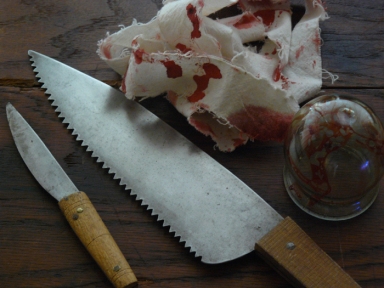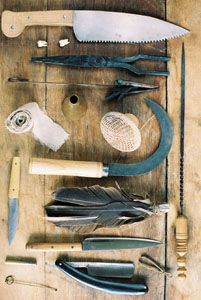 Visitors can hear the tales of the surgeon and the grim realities of her job. Hear her describe an amputation, how to kill a tooth worm, why holes were sometimes drilled in the head, the extraction of an arrow from the face of a Prince or meet the live blood sucking leeches and find out how they were used. This and more she relates to your visitors. Younger visitors can also help by mixing up a plague cure from safe kitchen herbs.
Visitors can hear the tales of the surgeon and the grim realities of her job. Hear her describe an amputation, how to kill a tooth worm, why holes were sometimes drilled in the head, the extraction of an arrow from the face of a Prince or meet the live blood sucking leeches and find out how they were used. This and more she relates to your visitors. Younger visitors can also help by mixing up a plague cure from safe kitchen herbs.
This display is run for passing trade throughout the day or as 3 to 4 timed talks a day.
 The cause of disease – a medieval belief
The cause of disease – a medieval belief
Medieval people had no knowledge of germs, they had no microscopes so they could not even see the tiny germs. They still believed in an Ancient Greek idea called the 4 humours. The human body was said to be made of 4 humours or liquids, blood, yellow bile, black bile and phlegm. Every time a person was sick a liquid would come out of their body such as blood or mucus. They believed therefore that illness must be caused by an imbalance of the humours. Perfect logic if you don’t know about germs.
 Bloodletting & Purging
Bloodletting & Purging
It was common practice in medieval times to visit your surgeon 3 or 4 times a year to be bled. Bleeding or bloodletting was a common cure for many illnesses but especially for the plague. So popular was it, they even bled their animals such as horses. There were several ways you could be bled: with a knife and bowl, with cupping glasses or with live leeches! The trick was to bleed the patient to the point of fainting but inevitably some patients were left too late.
Bloodletting was one way to purge a humour, other ways included giving emetics to make people sick, diuretics to make them pee or worst of all laxatives to purge their bowels. Laxatives could be taken orally but were also regularly administered in the form of a medieval enema, a cleaned out pigs bladder would be attached to a small brass pipe. The bladder was then filled with herbs, honey, water, bran and such similar things and admistered.
 Surgery
Surgery
With little knowledge of the of the human body, disease and basic pain relief, medieval surgeons could never be described as great. The average life expectancy of a person was early 30s. Amputation was a common occurrence after battles. If a limb became infected with gangrene it had to be cut off. Live with one arm or die with two! The patient may not even have been sedated as some surgeons thought pain essential to heal the body. If they were it would have been probably a mixture of opium, mandrake and various other poisonous plants. If the patient survived his sedation the surgeon would use a curved knife to cut round the limb and cut through the flesh down to the bone. But a curved knife is no good for a hard substance like bone so the surgeon would now swap to his bone saw and saw through the bone, completely removing the arm. To stop the patient bleeding, hot cauteries or boiling oil would be applied to the stump. If the patient was lucky he would survive this and not die of blood loss, shock or infection!
Medicines
Medieval medicines were mostly made of herbs and other pleasant things like honey. They could also include for the richer patients such things as spices or gold but they might also require less wholesome sounding ingredients such as the blood of a swallow or the gall bladder of a dog!
Kids in particular love to hear the gruesome tales of the surgeon!

You must be logged in to post a comment.